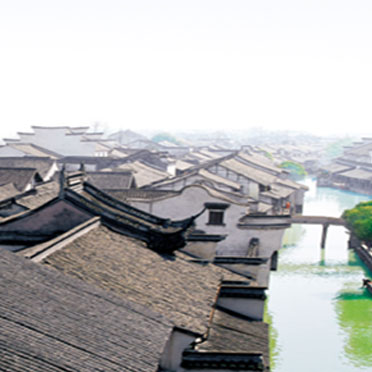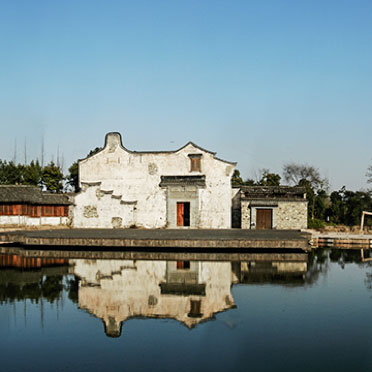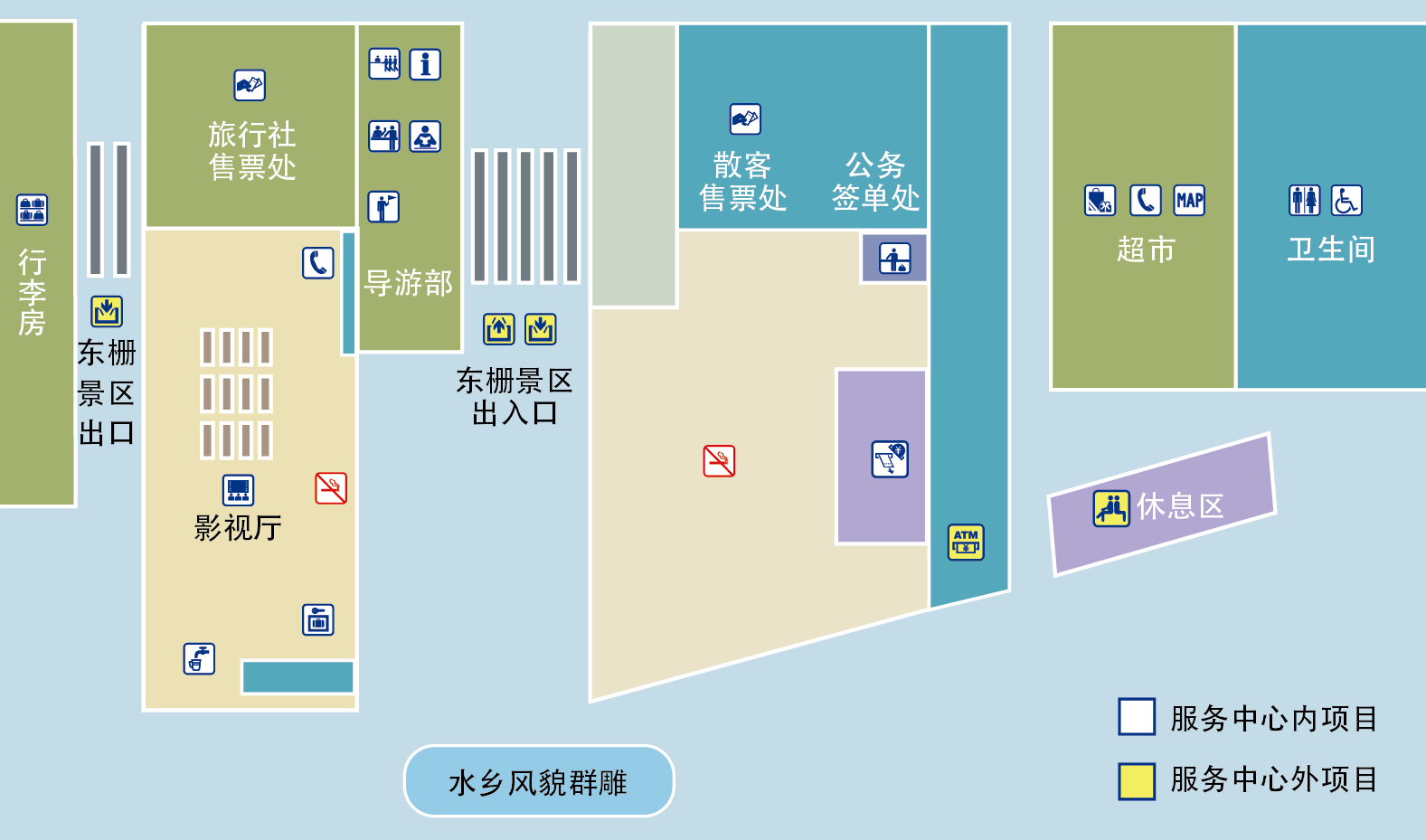



Wuzhen, as one of the first batch of ten famous historical and cultural towns in China, one of the top ten charming towns in China and a town with beautiful environment in China, is known as "the last pillow water family in China". In 2023, Wuzhen Wu Village won the award of "2022 Rural Tourism Revitalization Benchmark Project" and the "National List of Preferred Projects for the Integration of Intangible Cultural Heritage and Tourism Development" in 2022. Wuzhen Scenic Spot became the only scenic spot on the list in Zhejiang Province and was successfully selected as one of the "Intangible Cultural Heritage Scenic Spots". In 2022, Wuzhen Scenic Spot was listed on the second batch of public list of national night culture and tourism consumption gathering areas.


Wuzhen Geography
Geographical position
Wuzhen is Located at the northern end of Tongxiang City, Zhejiang Province, and in the center of the rich Hangjiahu Plain. Historically, it used to be the intersected place for two provinces (Zhejiang and Jiangsu), three governments (Jiaxing, Huzhou and Suzhou) and seven counties (Tongxiang, Shimen, Xiushui, Wucheng, Gui 'an, Wujiang and Zhenze). There is a county-level highway Yao-Zhen line running through the town, and it can be connected with provincial salt lake highway, national highway 320, national 318, Shanghai-Hangzhou Expressway, Shanghai–Jiaxing–Huzhou Expressway and Zhapugang-Jiaxing-Suzhou Expressway via Yao-Zhen highway. Wuzhen is 13 kilometers away from Tongxiang city, 27 kilometers away from Jiaxing, 45 kilometers away from Huzhou and 60 kilometers away from Wujiang, 80 kilometers away from Hangzhou and Suzhou, and 140 kilometers away from Shanghai. The town’s area is 79 square kilometers, and the urban area is 2.5 square kilometers.
Climate of four seasons
Wuzhen, located in the southeast coast, has a typical subtropical monsoon climate. It is warm and humid with abundant rain and sunshine, and is characterized by cold winter and hot summer, warm spring and cool autumn, and distinct four seasons. The annual average temperature is 16.1℃. January is the coldest, with an average monthly temperature of 3.6℃. July is the hottest, with an average monthly temperature of 28.1℃. The average annual precipitation is 1233.9 mm, and there are three obvious precipitation periods throughout the year, namely April-May (spring rain), June-July (plum rain), August-September (autumn rain), and it will snow in winter.




East Gate Project
Wuzhen is an ancient town in Jiangnan with a history of 1300 years. The cross shaped inland water system divides the town into four blocks, east, south, west and north, and local people refer to them as "East Gate, South Gate, West Gate, and North Gate" In 1998, Wuzhen entrusted the Urban Planning and Design Institute of Shanghai Tongji University to compile the Wuzhen Ancient Town Protection Plan, which clearly defined the overall development direction of Wuzhen Ancient Town protection and tourism development. The entire ancient town was divided into four different levels of protection areas: absolute protection zone, key protection zone, general protection zone, and regional control zone. Different levels of protection measures and protection ranges were proposed, with a buffer area of 198 hectares.
In 1999, after a thorough investigation, the Overall Plan for the First Phase of Wuzhen Ancient Town Renovation and Protection and a detailed restoration and renovation plan were formulated for the Wuzhen East Gage Block Protection and Development Project, and the East Gate Project for the protection and development of Wuzhen Ancient Town began to implement, abbreviated as the "East Gate Scenic Spot". In the comprehensive implementation process of the plan, in order to achieve the goal of "four most" (i.e. the most thorough protection, the most beautiful environment, the most complete functions, and the most scientific management), Wuzhen has implemented "three major projects" including heritage protection engineering, cultural protection engineering, and environmental protection engineering. In the national protection of ancient towns and cities, Wuzhen has pioneered and successfully operated the "pipeline burying", "toilet renovation project", "desilting project", "flood light project", "intelligent management" and other protection modes. The former Jiangnan Pearl brushed off its dust and revitalized it with a moving brilliance.
In 2001, the East Gate Scenic Spot of the first phase of Wuzhen Protection and Development Project was officially opened to the public. With its authentic water town style and profound cultural heritage, it has become a famous ancient town tourist destination in China. The effective exploration of the protection and development modes of ancient towns in Wuzhen has also been recognized by experts and peers, and is praised by the UN expert investigation team as the "Wuzhen Model" of ancient town protection in China.
While showcasing the extraordinary charm of ancient Chinese culture and the traditional essence of Eastern life, Wuzhen has also become a disseminator of traditional culture and an envoy for cultural exchange between China and foreign countries.



West Gate Project
The first phase protection project in Wuzhen successfully has protected its precious historical landscape and heritage, while also bringing vitality to the local economy of Wuzhen. However, due to its area only accounting for about a quarter of the total area of Wuzhen, there are still a large number of classic Ming and Qing architectural complexes in Wuzhen that need to be protected and repaired. In addition, due to geographical limitations, Wuzhen cannot provide more comprehensive services for tourists. Therefore, from 2003, Wuzhen started the provincial key project – the second phase Protection of Wuzhen Ancient Town (West Gate Scenic Spot), and invested heavily in the protection and development of West Gate Street.
Compared to the first phase of the protection and development project, the protection and development of the West Gate Scenic Spot in the second phase are more complete and thorough, and people, environment, nature, and architecture are more harmonious. There are over 300,000 square meters of exquisite Ming and Qing architecture preserved in the scenic spot. The length of West Gate Old Street, which runs from east to west of the scenic spot, is 1.8 kilometers, and the waterfront pavilions on both sides stretch for over 1.8 kilometers. There are nearly 10,000 meters of crisscrossing river channels and 72 ancient stone bridges of different shapes inside, with the highest river density and number of stone bridges among ancient towns in China. The northern area of the scenic spot is a natural wetland of over 50,000 square meters. The biggest difference between the first phase and the second phase of the scenic spot is that the first phase is a "sightseeing" scenic spot similar to other ancient towns, while the second phase is an unprecedented "sightseeing and leisure experience" water town scenic spot. The ancient town is no longer just a "living fossil" or "museum", but a perfect integration of sightseeing and vacation functions, becoming a tranquil oasis away from the hustle and bustle.
The scenic spots, workshops, classic exhibition halls, religious buildings, folk customs and leisure places in the block make people linger, with beautiful natural scenery and magnificent floodlit night scenes. There are also various styles of residential guest rooms, various grades of holiday hotels, a number of well-equipped conference centers and business halls in the scenic spot; Tourist service center, sightseeing bus, sightseeing boat, water bus, direct drinking water, natural gas, broadband network, satellite TV, electronic patrol, floodlighting, star-rated toilets and intelligent tourist parking lots are all available.
With the organic integration of history, culture, nature, environment and humanities, and advanced and perfect service facilities, Wuzhen has truly become a tourist destination for sightseeing, leisure, vacation and business activities.
Applying advanced management concepts to the protection of ancient towns, Wuzhen has effectively explored the protection and development modes of ancient towns and accumulated successful experience. For instance, pipeline burying, river cleanout, repairing the old and controlling over-commercialization, etc., are all examples of the first or successful operation in the protection and development of ancient towns in China, which have been affirmed by experts and peers and praised by the UN expert investigation team as the "Wuzhen model" for the protection of ancient towns.
Features of East Gate and West Gate Scenic Spots
East Gate water town has a complete landscape and a rich flavor of life. Handmade workshops and traditional shops have their own features, and the featured exhibition halls are dazzling. While enjoying the original scenery of the water town, tourists can also enjoy the pleasure of traveling, shopping and food gluttony. Compared with West Gate, East Gate is small and lean, which is suitable for tourists to take a day or two to appreciate the customs of the ancient water town.
After four years of hard work and investment of over one billion yuan, West Gate Scenic Spot covers an area of 4.92 square kilometers and is composed of twelve islands surrounded by clear water, truly presenting the style of an ancient town in Jiangnan, China. The West Gate block retains a large number of ancient buildings from the Ming and Qing dynasties and old streets and alleys. The exterior of the ancient buildings retains the ancient charm, while the interior is selectively enriched with modern supporting facilities. While greatly improving the living conditions of the indigenous people, it also provides tourists with a comfortable living environment and comprehensive leisure and entertainment. Here, you can deeply experience the simple and fresh water town life, while also enjoying the comfort and convenience of modern life. It can be said that West Gate is a tranquil oasis far from the hustle and bustle of the city, and a perfect tourist destination that combines sightseeing and vacation functions.


